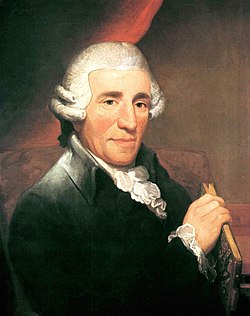Symphony No. 50 (Haydn)

Symphony No. 50 in C major, Hoboken I/50, by Joseph Haydn was written partly in 1773[1][2][3] and partly in 1774.[4]
Scored for 2 oboes, 2 horns, 2 trumpets, timpani and strings.[5] Since the trumpets double the horns at the same pitch for most of the piece, Antony Hodgson has suggested the trumpets may be omitted.[6] The edition by Helmut Schultz published by Universal Edition under the editorship of H. C. Robbins Landon specifies horns in C-alto with trumpets in parentheses. It is in four movements:
- Adagio e maestoso, 4
4 – Allegro di molto, 3
4 - Andante moderato, 2
4 in G major - Menuetto e Trio, 3
4 - Presto, 2
2
It is possible that the first two movements of this symphony were reconstructed from a marionette opera by Haydn called Der Gotterath (Prologue to Philemon und Baucis), now lost. The marionette show was performed for the Empress Maria Theresa in 1773.[7]
Given that Empress Maria Theresia held rather conservative tastes in music and that this symphony is in some ways less "advanced" than No. 48, scholars such as H. C. Robbins Landon have suggested that No. 50 may be the symphony Haydn wrote for the imperial visit to Eszterháza.[6]
Notes
[edit]- ^ Antony Hodgson, The Music of Joseph Haydn: The Symphonies. London: The Tantivy Press (1976): 77. No. 50 "is the only symphony to which the year 1773 can be ascribed with certainty."
- ^ James Webster & Georg Feder, The New Grove Haydn. New York: Macmillan (2002): 96. Movements I and II were "supposedly composed as ov[erture] to Vorspiel: Der Götterat (E 12)."
- ^ Webster & Feder (2002): 83. "E ... 12 XXIXa:1, 1a; XXIXb:2 Philemon und Baucis, oder Jupiters Reise auf die Erde (Spl/marionette op, 1, G.K. Pfeffel); Vorspiel: Der Götterat (1, ?, P.G. Bader) 2 S, 2 T, 4vv, ? 2 fl, 2 ob, ? bn, 2 hn, ? 2 tpt, timp, str [1773] EK, signed lib, HL a (frag., u) HW xxiv/1 supposed ov. (cf J 50) and frag. of prelude extant, drama extant in rev. version; perf. Eszterháza, 2 Sept 1773; ov. to drama, HIa:8; cf appx G. 1, 1
- ^ Webster & Feder, (2002): 64. Haydn's symphonies of the years around 1770 ... are widely described as exemplifying his Sturm und Drang style; those of 1773–4 (nos.50, 51, 54–7, 60, 64), while less extreme, have many points of contact with it."
- ^ Webster & Feder (2002): 96
- ^ a b Hodgson (1976): 77
- ^ H. C .Robbins Landon, Haydn: Chronicle and Works, 5 vols, (Bloomington and London: Indiana University Press, 1976– ) v. 2, Haydn at Eszterhaza, 1766–1790


 French
French Deutsch
Deutsch